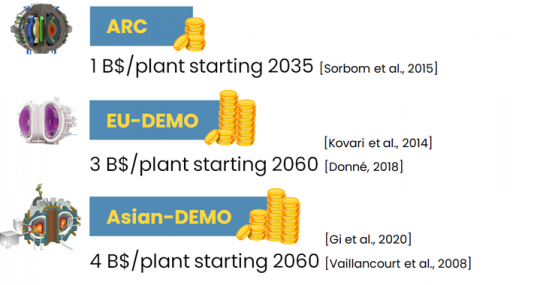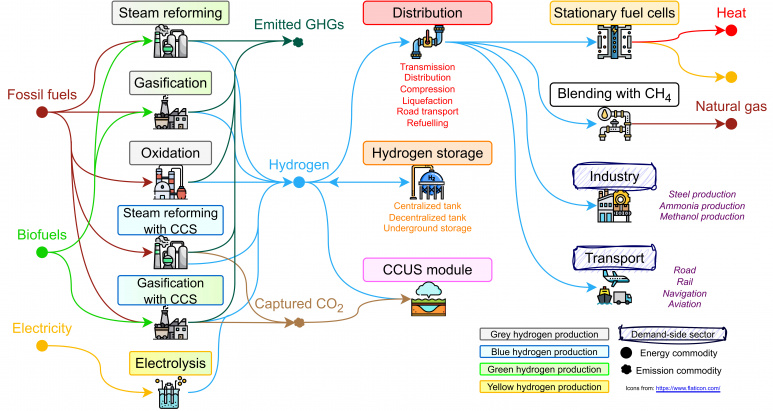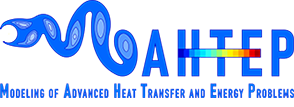Development of technology modules
1. Fusion
Nuclear fusion represents one of the most promising technologies that may help the transition towards a decarbonized electricity system on the long run. While being disputed that it may come too late to effectively contribute to mitigate climate change-related issues, research is focusing on a wide set of options for fusion reactors.
A preliminary study carried out by MAHTEP characterized three nuclear fusion technological alternatives based on the ARC, EU-DEMO and Asian-DEMO reactor concepts according to the publicly available literature, as reported in Figure 1. The details of this preliminary modeling and the results of its integration in the EUROfusion TIMES Model is available in [1].

Figure 1. Summary of the nuclear fusion reactor technologies characterized for TEMOA-Europe.
Moreover, constraints based on the S-curves technology adoption model [2] are derived to reasonably bound their adoption in the model. Results concerning installed capacity trends and contribution to the electricity mix on a time scale up to 2100 obtained using the EUROfusion TIMES Model show that fusion does not contribute at all to the energy transition in Europe and the US. On the other hand, it may get a non-negligible space in a context of growing electricity demand, contributing to satisfy stringent environmental constraints together with other low-carbon power technologies in the second half of the century.
2. Hydrogen
In collaboration with: ENEA, E4SMA
The hydrogen value chain is rich of technologies, many of them already fully commercialized, other still in a R&D phase. The techno-economic characterization of the processes involved along the production, storage, delivery and end-uses stages is fundamental to frame the possible role of the hydrogen in the future energy mix.
Indeed, this activity aims to produce a techno-economic module embracing the whole hydrogen value chain (see Figure 2). The considered data are: investment costs, and fixed and variable operation and maintenance ones, efficiency, availability factor and lifetime. All the steps of the hydrogen value chain are considered. In particular:
- Production: From a high-level perspective, the production phase involves the grey hydrogen from fossil fuels, the blue one from fossil fuel with carbon capture, the green one from renewable energy sources and the pink one from nuclear power and heat.
- Storage and Delivery: the steps involved in this phase are strictly related to the production technology (e.g., centralized or decentralized) and to the end-use (e.g., gaseous or liquid phase).
- Consumption: all the possible consumption sectors that can be decarbonized through hydrogen are included, namely the power sector, industry, transport, residential, commercial and agriculture. Also, sector coupling potential can be explored with the possibilities of modeling blending with natural gas and synfuel production.

Figure 2. The hydrogen sector currently implemented in our model instances [3].
This activity is being carried out on two different levels. Firstly, as a continuation of the thesis project of Alessandro Balbo [4] (also presented in [5] and [3]), he hydrogen potential as energy storage vector for renewable electricity will be explored, assessing its validity in helping the grid integration of variable renewable energy sources. In this regard this study will require the combined use modeling frameworks: energy system optimization models, to assess macro-scale long-term scenarios, and dispatchment models, to identify short-term criticalities in the supply-demand equilibrium satisfaction. The activity will be carried out in collaboration with ENEA.
Simultaneously, the techno-economic characterization is also undergoing update process in collaboration with E4SMA, in the framework of a master thesis.
3. Storage
In collaboration with: North Carolina State University
When modeling energy storage inside ESOMs, technologies are typically represented as part of the energy supply mix and are used to flexibilize the use of renewable energy resources and reduce the reliance on fossil fuel generation. How energy storage is included in such models generally depends on model scale, scope, and application. In this context, we aim to investigate this problem and develop a more realistic representation of energy storage to be used in TEMOA. In this process we will attempt to capture the dynamics short-term operations due to renewable energy production and energy storage charge/discharge within hourly discretization and connect this into long-term capacity expansion decision-making.
The joint research activity is aimed at analyzing the possible role of energy storage technologies in the future energy system though energy system optimization models. The activity will be structured according to the following steps:
- Techno-economic characterization of a comprehensive set of alternative energy storage technologies (electricity storage, hydrogen storage, pumped-hydro storage etc.), collected in a dedicated technology module compliant with the TEMOA formulation.
- Identification of a proper modeling strategy, including the refining of the model time scale and the optimization of the model algorithm to reduce the consequently increased computational cost.
- Identification of the model instance (the case study) in which to integrate the new technology module and modeling strategy.
- Implementation of future scenarios for the analysis of the possible penetration of storage technologies in the energy system in different conditions.
- Development of a post-processing module capable to easily extract and visualize TEMOA results, including the possibility to investigate results on different aggregation levels on the time scale.
- Analyzing the role of energy storage in supporting the penetration of renewable energy sources in the electricity generation mix and its impact on transport sector.
References
- D. Lerede, M. Nicoli, L. Savoldi, and A. Trotta, “Analysis of the possible contribution of different nuclear fusion technologies to the global energy transition,” Energy Strategy Reviews, vol. 49, no. 101144, Sep. 2023, doi: 10.1016/j.esr.2023.101144.
- D. Lerede and L. Savoldi, “Might future electricity generation suffice to meet the global demand?,” Energy Strategy Reviews, vol. 47, p. 101080, May 2023, doi: 10.1016/J.ESR.2023.101080.
- G. Colucci, D. Lerede, M. Nicoli, and L. Savoldi, “A dynamic accounting method for CO2 emissions to assess the penetration of low-carbon fuels: application to the TEMOA-Italy energy system optimization model,” Appl Energy, vol. 352, no. 121951, Dec. 2023, doi: 10.1016/j.apenergy.2023.121951.
- A. Balbo, “Will hydrogen be a game-changer in the Italian decarbonization pathways? Exploiting an Energy System Optimization Model for scenario analysis,” Politecnico di Torino, 2022. Accessed: Feb. 10, 2023. [Online]. Available: https://webthesis.biblio.polito.it/24983/
- A. Balbo, G. Colucci, M. Nicoli, and L. Savoldi, “Exploring the Role of Hydrogen to Achieve the Italian Decarbonization Targets Using an Open-Source Energy System Optimization Model,” in International Journal of Energy and Power Engineering, E. and T. World Academy of Science, Ed., Mar. 2023, pp. 89–100. Accessed: Apr. 24, 2023. [Online]. Available: https://publications.waset.org/10013040/exploring-the-role-of-hydrogen-to-achieve-the-italian-decarbonization-targets-using-an-open-source-energy-system-optimization-model

